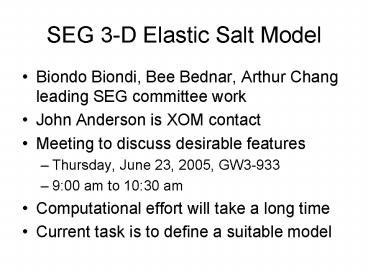SEG 3-D Elastic Salt Model - PowerPoint PPT Presentation
Title:
SEG 3-D Elastic Salt Model
Description:
SEG 3-D Elastic Salt Model Biondo Biondi, Bee Bednar, Arthur Chang leading SEG committee work John Anderson is XOM contact Meeting to discuss desirable features – PowerPoint PPT presentation
Number of Views:54
Avg rating:3.0/5.0
Title: SEG 3-D Elastic Salt Model
1
SEG 3-D Elastic Salt Model
- Biondo Biondi, Bee Bednar, Arthur Chang leading
SEG committee work - John Anderson is XOM contact
- Meeting to discuss desirable features
- Thursday, June 23, 2005, GW3-933
- 900 am to 1030 am
- Computational effort will take a long time
- Current task is to define a suitable model
2
3-D SEG Acoustic Salt Model
snap shot at 781 ms
source
snap shot at 1450 ms
3
Acoustic (18 Hz peak)SEG Salt model (2 data sets)
- 45 shot data set
- 5 lines
- 9 shots/line
- 201 by 201 receiver grid per shot (40 m spacing,
wide azimuth, source at center of grid, 40401
receivers/shot) - ideal for shot record migration
- 4800 shot data(C3-NA)
- 50 lines, 160 m cross-line spacing
- 96 shots / line, 80 m shot spacing
- 8 cables, 40 m group interval within a cable
- 68 receivers / cable
- 544 receivers / shot
- simulates marine acquisition
4
Single raw 3-D shot record (8 streamers, C3-NA)
Numerical dispersion
Original SEG SALT model data
Each streamer has 68 receivers 40 m apart. The
entire survey is 50 lines with 96 shots per line.
Time sample rate is 0.008 s, with 625 samples
per trace
5
Computational Size of Problem
- For 3-D acoustic SEG Salt model
- Using model parameters for data without
dispersion - 441 shot wide-azimuth data set
- 21 lines of 21 shots each, receivers at every
grid point - 650 GB if SEGY, 400 CPU days on old hardware
- Aimed at ideal conditions for shot migration
- For 3-D elastic model (similar to acoustic model)
- scale compute time by roughly 144
- Vs 0.5 Vp requires finer grid by factor of 2
- Computation time scale factor is 1624
- 3 components x 3 terms factor of 9
- Data set volume grows by factor of 3
- Doubling bandwidth requires factor of 1624
6
Marmousi II 2-D Elastic Model (University of
Houston)
Vp
Low p-wave velocity simulating hydrocarbons to
give AVO response
Flat spot on target
Vs
AVO modeling requires Vp, Vs, and Density
Density
Synthetic data have 80 Hz bandwidth
7
SEG 3-D Elastic Salt Model
- Key desirable features
- (1) smooth and rugose (both deep notches and
chirp signal) Top of Salt (TOS) components - (2) shallow salt with impedance match to give
large P-S conversions - (3) deeper salt matched for P-P
- (4) multiple salt bodies, one obscuring portions
of the other - (5) compaction model for subsalt region honoring
differences between salt and sediment overburdens
8
SEG 3-D Elastic Salt Model
- Key desirable features
- (6) overpressure zone for part of subsalt zone
- (7) sediment profile with some AVO target
anomalies - (8) reservoir zones with compartmentalization
- (9) variations in the Base Of Salt (BOS) (steep
ramp to flat, gentle ramp to flat) - (10) subsalt sediments that truncate steeply
against the BOS
9
SEG 3-D Elastic Salt Model
- Key desirable features
- (11) realistic salt tectonics including faulting
and structures in the sediments corresponding to
deep salt withdrawal and slip interfaces - (12) deep carbonate with rift faults near bottom
of section. - (13) components for calibrating image quality
- deep horizontal reflector at bottom
- isolated point diffractors
10
Sediment structures are related to salt tectonics
Allochthonous Salt
Autochthonous Salt
11
(No Transcript)
12
Salt
Salt
Autochthonous salt weld
13
(No Transcript)
14
Realistic Plan
- Begin with a fully elastic model, progress as
compute capacity grows - Acoustic model data set
- Elastic multicomponent data set
- Anisotropic multicomponent data set
- Begin collecting data over subsets of the model
- Subsets of the model could target different
geologic objectives - Over time merge surveys to cover entire model
- Surface, OBC, and VSP data
- Both absorbing and reflecting surface boundary
conditions - Zones of very dense sampling
- Could we have an equivalent physical model done
at Delft or University of Houston or elsewhere? - Can we get elastic physical models?































